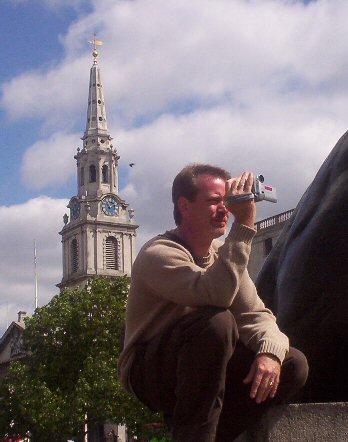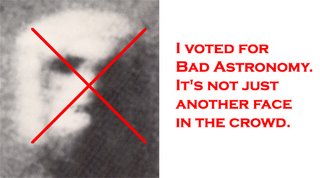-
On 7/31/2006 06:19:00 AM, Lifewish waxed damned near poetic whilst opining...
-
Is everyone else enjoying it as much as we are?
It's an excellent spectator sport :)
I'm only sorry you've had to waste so much time on JAD.
-
On 7/31/2006 07:12:00 AM, JanieBelle waxed damned near poetic whilst opining...
-
And yet, in a way, we owe DAJ a bit of thanks. Without him, the Big Green Marker would never have evolved. There would have been no selective pressure.
When he first showed up, we just laughed at him, but his comments remained, assinine as they were.
Graffitti on a perfectly good blog.
His insane rantings continued, so something more drastic was necessary.
We began to delete his comments.
His inane screams got louder, and more ridiculous. Our readers really wanted to read some of his lunacy, in order to poke fun of him. At the same time, we were having issues with folks posting links. If the links weren't tagged exactly right, they messed up the home page because of the poorly written template, and its interaction with the "recent comments" script.
We found a script that would allow us to edit our commenters' comments. It was intended for the purpose of fixing tags, so we wouldn't have to delete and repost folks' comments. It got co-opted for use as an homage to DaveScot, where we could put quick thoughts into a commenter's remarks.
DAJ's ravings continued, and became spam-like.
Selective pressure caused our editorializing to grow first into boldface markings. For clarity, and and the selective pressure of being absolutely sure our remarks were discernable from the original commenter's, it began to take on colorful hues, eventually weeding out all but the green genes.
At this point, Janie went through and straightened out the original, defective, Blogger template html, and later she changed to a different "recent comments" script altogether, so its original use was no longer necessary, but it had taken on new purpose at UDOJ.
And thus, the Big Green Marker that you see today, evolved from its humble beginnings due to selective pressure from DAJ.
In a way, he did it to himself.
It's a pretty good analogy of biological evolution, and we got to watch it in real time.
Kisses,
Kate
-
On 7/31/2006 07:20:00 AM, Lifewish waxed damned near poetic whilst opining...
-
You're not telling me it wasn't intelligently designed, are you?
The Marker, I mean, not JAD.
-
On 7/31/2006 07:38:00 AM, JanieBelle waxed damned near poetic whilst opining...
-
Oh, not at all. It evolved. I just went back and added to my last comment. Sort of an elaboration of the original "Theory of Digital Evolution of The Big Green Marker"
Feel free to try to refine the theory, and we'll have a peer review of your work.
Kisses
Kate
-
On 7/31/2006 07:47:00 AM, JanieBelle waxed damned near poetic whilst opining...
-
And remember, lifewish.
You must present evidence for your paper to even be considered.
Kisses,
Kate and Sleepyhead
-
On 7/31/2006 07:53:00 AM, Lifewish waxed damned near poetic whilst opining...
-
Actually, this is sort of an example of irreducible complexity forming. Specifically, the conflation of JAD and the edit script is now irreducibly complex, since:
1) without the edit script, JAD's long-winded trolls would kill this blog off
2) without JAD, there'd be no use for the edit script.
Of course, since we have a detailed description of how this pairing emerged, we can see that the original dodgy template provided a sort of scaffolding that supported the discovery of the edit script.
This "loss of scaffolding" is one of about three ways that irreducible complexity can come about. IC is one of those concepts that people have waaaay too much fun debunking - see, for example, the irreducibly complex mousetrap (with animations!)
-
On 7/31/2006 08:43:00 PM, JanieBelle waxed damned near poetic whilst opining...
-
Thank you, lifewish. I liked that page. Simple, silly examples are right up my alley.
I get it. So if a particular piece of a given organism looks now like it needs all it pieces to properly function, that doesn't mean it didn't evolve. The mousetrap example was cool, and the animations were cute (except the one that actually showed the mouse). But I still like the Big Green Marker. I see the parallels, though, and how they apply to "irreducible complexity".
Thanks again for sharing that.
-
On 8/01/2006 05:12:00 AM, Lifewish waxed damned near poetic whilst opining...
-
I get it. So if a particular piece of a given organism looks now like it needs all it pieces to properly function, that doesn't mean it didn't evolve.
Precisely. It could be that, in the past, it had redundancy or scaffolding that has since vanished.
Actually, there's another approach to producing IC structures embedded in this example: co-option. A script that had already "evolved" in one role was borrowed for use into a different context, in the finest traditions of jury-rigging :)
That sort of thing happens all the time in nature - evolution is very good at using all the resources to hand. It provides a partial explanation for such complex structures as the bacterial flagellum.
Now, if you look at a flagellum, it seems too horrendously complex and integrated to properly evolve. However, if you were a molecular biologist, you might note that the base of the flagellum looks strangely familiar. Turns out that there's a huge great chunk of it that's been copied wholesale from secretion systems.
So how did the flagellum come about? Well, first imagine if a bacterium got really really constipated...
(Or, more seriously, check here for a short version or here for a ridiculously long and involved version)
Here endeth the rambling.
-
On 8/01/2006 07:03:00 AM, JanieBelle waxed damned near poetic whilst opining...
-
Actually, there's another approach to producing IC structures embedded in this example: co-option.
Actually co-option was what I was thinking when I wrote that comment. See how good I'm getting at this teaching thing?
I should get a star on my paper. Maybe I'll go back to college with JanieBelle. I could be a science teacher.
Kisses,
Kate and JanieBelle
-
On 8/01/2006 07:22:00 AM, Lifewish waxed damned near poetic whilst opining...
-
Ah, right, think I lost the thread :-/
I defer to your excellent teaching abilities :)
-
On 8/01/2006 07:29:00 AM, JanieBelle waxed damned near poetic whilst opining...
-
Sorry, Lifewish. I should have just signed that last comment with my name instead of both.
You're all good. Keep teaching, I was just clowning.
Kisses,
Kate
-
On 8/01/2006 07:34:00 AM, JanieBelle waxed damned near poetic whilst opining...
-
As much of a pain in the butt as it will be, Janie and I are thinking I should open my own separate Blogger account.
It might help cut the confusion.
Up to this point, we've just signed our names on our comments. I've only got 19 and a wake up until I'm out of the Corps completely, so it's probably safe for me to do that.
Switching accounts back and forth might be a pain, though.
Anyone else having trouble following who says what?
Kate
-
On 8/02/2006 08:04:00 AM, DaveScot waxed damned near poetic whilst opining...
-
It could be that, in the past, it had redundancy or scaffolding that has since vanished.
And of course, in Darwinian science, "could be" is as good as a fact because, when you think about it, the Darwinian narrative is nothing but a collection of "could bees" describing a process that is unrepeatable, undemonstrable, and unpredictable. The only "could be" missing from the Darwinian dogma is that it "could be wrong". LOL - I kill me sometimes.
-
On 8/02/2006 08:22:00 AM, DaveScot waxed damned near poetic whilst opining...
-
Turns out that there's a huge great chunk of it that's been copied wholesale from secretion systems.
As it turns out, that's bass ackwards. Every bit of chronological evidence we can identify indicates that the bacterial flagellum preceded the appearance of the type III secretory system in nature.
Thus the TTSS represents the flagellum devolving into the TTSS rather than TTSS evolving into the flagellum.
Now ask yourself what's more likely without intelligent agency; a complex structure devolving into something simpler or a simple structure evolving into something more complex. Is it more likely that without intelligent design an oxcart will get an engine and transmission added to it or a flatbed truck with a non-working motor will get an ox added to it?
Even if there is some co-option going on, which is entirely plausible, it STILL has to be demonstrated in a stepwise fashion what the chain of events was and how each step along the way had enough fitness advantage to become fixed in the population. Oh hold it, I forgot, Darwinian evolution is held to a different standard. "Could be" is as good as a fact. Since it could be that the flagella is a co-opted and improved TTSS that's as a good as fact. Sorry about that.
I blogged on this more than once in the past. See what I mean about endless repetition? It's no small wonder I don't care to repeat myself ad infinitum.
-
On 8/02/2006 09:00:00 AM, Lifewish waxed damned near poetic whilst opining...
-
And of course, in Darwinian science, "could be" is as good as a fact because, when you think about it, the Darwinian narrative is nothing but a collection of "could bees" describing a process that is unrepeatable, undemonstrable, and unpredictable.
You inexplicably seem to have missed out phase 2 of the process, whereby we attempt to draw and test predictions on the one hand and to find better hypotheses on the other hand.
So far it's been fairly successful*, and there are no other hypotheses that even come close.
As it turns out, that's bass ackwards. Every bit of chronological evidence we can identify indicates that the bacterial flagellum preceded the appearance of the type III secretory system in nature.
Actually, IIRC, that was guess 2 at how things happened. Guess 3 (dominant as of 2003) suggests that the modern type III secretory system and the relevant parts of the modern bacterial flagellum descend from an ancestral export system. There's an obnoxiously long essay on the subject.
I'm still trying to understand the material myself - will respond in more detail when I get it clear in my head.
Now ask yourself what's more likely without intelligent agency; a complex structure devolving into something simpler or a simple structure evolving into something more complex.
I'd say the latter. There is a comparatively small number of different combinations of parts that you can pull off an existing object, but there's a huuuuge number of different things that could be added on to it. Adding stuff allows evolution to get imaginative.
* As usual, if I make a comment like this, it means that there's an obnoxiously long list of standard examples available on demand












